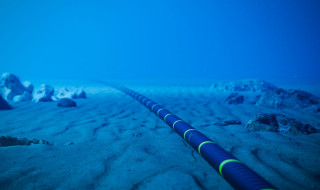SURF network
Network innovations
Fibre sensing: today's technology
Fibre sensing is a technology in which fibre-optic cables are used as sensors. This technology allows us to monitor not only the fibre itself, but also its immediate surroundings. For example, strain, pressure, vibration, temperature and other physical parameters are measured. Both within the cable and in the environment in which it is located. Want to know more? This Wikipedia page tells you more about fibre sensing, its different variants and how it is applied.
Conducting new research using fibre sensing
With fibre sensing, fibre-optic cables are used as a network of sensors. These cables do not only transport information, but also actively contribute to generating new knowledge and creating new data. For instance, data are collected on strain, pressure, vibration, temperature and other physical parameters. By using existing equipment and infrastructure, there is no need to install new equipment in hard-to-reach places, such as underwater. This provides valuable insights for a wide range of research fields, such as earth sciences, biology and environmental sciences.

With fibre sensing, even a hard-to-reach place such as the ocean floor becomes a valuable source of measurement data.
The potential of the SURF network
The development of fibre sensing is one of the specialised and innovative network applications for specific use cases. While using the optical fibres of the SURF network, we actively explore the potential of fibre sensing. We do so with trials and collaborations with various partners. In this way, we contribute to the development of new applications and increase knowledge about this promising technology.
The technique of fibre sensing is already known in some research disciplines. Yet it is mainly an innovative new technique whose potential still needs to be explored. SURF has its own nationwide fibre-optic network with international connections. This totals about 11,000 kilometres of fibre-optic cables on which fibre sensing can be applied. In projects that want to investigate and deploy the potential of fibre sensing, we actively contribute ideas on how SURF's fibre-optic network can be used.
SURF's fibre sensing projects
These are the projects in which SURF is exploring the potential of fibre sensing, together with various partners.
Submarine cables for marine biology
Together with GÉANT, Wageningen Marine Research (WMR) and Norwegian University of Science and Technology (NTNU), we are working on applying Distributed Acoustic Sensing (DAS) to a submarine cable from Zandvoort (NL) to Leiston (UK).
This trial focuses on the use of fibre sensing for marine biological research in the North Sea. Visit the SUBMERSE website for more information, and take a look at the video below to learn more about the project.
Seismic research into geothermal energy
The large-scale seismic survey of the Amsterdam metropolitan region is collecting detailed data on the subsurface, which is needed for the development of geothermal energy as a sustainable resource. The seismic survey will be conducted by SCAN (Seismic Campaign Geothermal Netherlands) and will start in autumn 2025.
In this project, SURF is collaborating with TNO, which is conducting seismological research. We are providing fibre-optic cables and colocation in Amsterdam. Through this collaboration, we exchange knowledge on fibre-optic infrastructure and fibre sensing techniques.
Want to know more about fibre sensing or get involved?
Read more about fibre sensing at SURF on the wiki.
Do you work at an institution affiliated to SURF and think fibre sensing could support your research? Please contact karin.wessel@surf.nl